 Archive for July, 2010
Archive for July, 2010
Interview Archive with Charles Kirk
July 30, 2010 at 2:20 pm
 Today’s live interview with Charles Kirk of The Kirk Report was a lot of fun, and I hope you were able to join us for the discussion.
Today’s live interview with Charles Kirk of The Kirk Report was a lot of fun, and I hope you were able to join us for the discussion.
GS Getting Ready
July 27, 2010 at 7:23 am
Financial stocks are always on the radar of traders, and GS is usually at the top of the list. Interestingly, this one looks like it’s gearing up for a move of its own.
After undercutting support on July 1st, the stock began to grind higher, eventually taking out the late-June high on strong volume. Since then, a rising trend line from the low has served numerous times as support. Over the past several sessions, some narrowing consolidation has been seen with the creation of a small descending trend line just overhead. These two trend lines are now squeezing price in a pressure-chamber fashion, and one of them is about to give.
Typically when two trend lines are vying for control, the longer one tends to win out. In this case, that could bring an upside resolution to this pattern. In keeping with the recent market strength, that’s a distinct possibility.
I’m watching GS for a push through the trend line at $149.10 for a trade. Earnings have already been released, and this is a highly liquid stock. Could be good for a few quick points, but the buyers will have to emerge and push prices beyond the trend line in order to get it. An unfilled gap from April extends to the $160 area.
If instead the lower trend line is broken (currently at $145), that would be a failure of this bullish pattern and would leave the stock vulnerable to at least a partial retracement of this bounce.
Here’s a closer look for you:

Trade Like a Bandit!
Jeff White
Swing Trading & Day Trading Service
www.TheStockBandit.com
Are you following me on Twitter yet?
Bidding On BIDU
July 26, 2010 at 7:19 am
When trades come along which offer potential on multiple timeframes, I always perk up. If one timeframe doesn’t appeal to me, the other can still add to my account.
BIDU is one such setup right here. The channeling stock has been range-bound since early May, and a breakout may be coming soon from this rectangle pattern. Upper resistance is well-defined, offering day traders a quick-hit setup for an intraday breakout play. But with confirmation of a breakout – meaning, a close above that resistance level – swing traders also have a shot at a measured move to develop in the coming weeks for a $12 advance to the $90 area.
A breakout could come any day in BIDU, so I’ve got it on my radar for a trade if it can push through the $78.65 resistance area. This one doesn’t have a real clear-cut exit as a swing trade, so it isn’t one I’m planning to keep a long time… Just long enough to get paid and move on to the next idea.
Here’s a closer look for you:
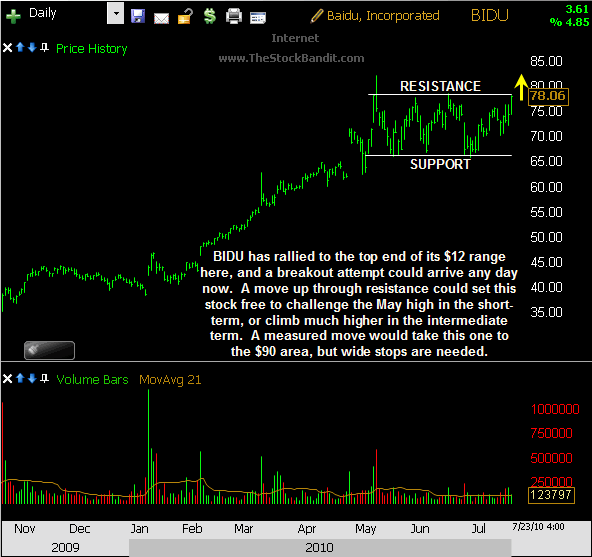
Trade Like a Bandit!
Jeff White
Swing Trading & Day Trading Service
www.TheStockBandit.com
Are you following me on Twitter yet?
Video Review of the Indexes 7-25-2010
July 25, 2010 at 11:32 am
Last week was potentially big for the bulls, not only in the short-term, but for the big picture as well.
We saw something happen which hasn’t happened since April – a dip was bought! After a nice rally from the July 1st low, a pullback had set in. But given the magnitude of that rally, there was a fair chance a higher low could be established on the dip…and it was.
The bulls now have an excellent opportunity to build on, but the key will be follow through and resolve on their part. They’ve struggled this year, but there’s lots of time left for stocks to recover.
As we head into a brand new week of trading, let’s examine some important levels to keep an eye on in the days ahead. That will have the greatest influence on how individual stocks are going to move, so it’s where the trading week begins.
This clip was also posted over on the Trading Videos site (as always), and perhaps you’ve seen it there – but in case you didn’t, I wanted to put it here on the blog for you.
Let me highly suggest clicking the “HD” on the video player and then going full-screen for best quality.
Trade Like a Bandit!
Jeff White
Swing Trading & Day Trading Service
www.TheStockBandit.com
Are you following me on Twitter yet?
Intraday Extremes Offer Big Opportunities
July 20, 2010 at 9:02 am
The old adage says to ‘buy low and sell high.’ That’s misinterpreted by most, as they tend to sell their strongest stocks when strength is still present or buy before corrections are completed.
To the inexperienced, it may look like the move is done, but often times is followed by an encore of sorts. Timing is everything, indeed.
Extremes can really pay quite well. When fear is at its highest, it’s a great time to get long. And when everybody and their mom is making money, it’s certainly time to raise cash. But for the sake of this post, I’m not talking about buying a “generational low” or calling a long-term top in the market. In fact, I’m not even referring to the daily timeframe here.
I’m talking about how some of the best trades will happen at extremes…
…the kind which are found intraday.
Profit Where Others Fail to Look
Define it however you like, but at the heart of it, an extreme is approaching quickly whenever a move is unfolding at an unsustainable pace.
That might be a parabolic uptrend, or intraday capitulation. An extreme is a price spike which is showing exceptional momentum now, but the enthusiasm is beginning to fade, and soon there’s going to be a reactionary move.
That reactionary move is the one you and I can catch most often. I say that because once we see a stock that’s really on the run, the odds are that the easy money has been made for that particular move. Attempting to join the move means chasing price without a clear-cut exit plan, and that’s a huge no-no for any professional trader. So, the reactionary move is the money train for those who missed the original move.
What’s so funny is that most traders see a huge intraday run and just know they missed it. Don’t be as closed-minded as them. They drool over what it would have been like to be on board, and fail to recognize the opportunity that’s about to unfold. Dare I say, a more defined-risk opportunity.
You Missed the ‘Move’ – So What?
Take Monday for example. Education stocks bolted higher in the morning, ripping through offers on the way up as they painted the tape bright green. By the time most of us noticed them, they’d already put up very impressive gains.
Maybe you saw APOL, ESI, COCO, DV and others up in the neighborhood of 10% in just the opening few minutes. It looked like they could keep going, but suddenly the buying frenzy morphed into profit-taking, and thus, opportunity arrived.
RIG provided an excellent move for me (from Sunday night’s premium newsletter), but my most profitable trade of the day actually came in a short sale of ESI. Let’s take a look…
ESI ripped higher by $9 right off the open Monday, but I wasn’t long. It was up about $6 by the time I noticed it, and I’m not a buyer of that kind of strength. So instead, I waited for the enthusiasm to wane. And shortly after, it did.
The stock had painted a high of $95.62, and then backed off slightly. It spent several minutes consolidating, and then on the 3-minute chart I saw something noteworthy. I shorted at $95.10, set a protective buy stop up above, and waited to see if profit-taking would develop.
An hour later, the stock was more than $6 lower, trading in the low $89’s, and I was out of the last of my shares (after scaling out). It didn’t last long, but the overreaction on the upside was followed by a nice reaction on the downside, and that was the move that paid me.
Here’s a closer look:
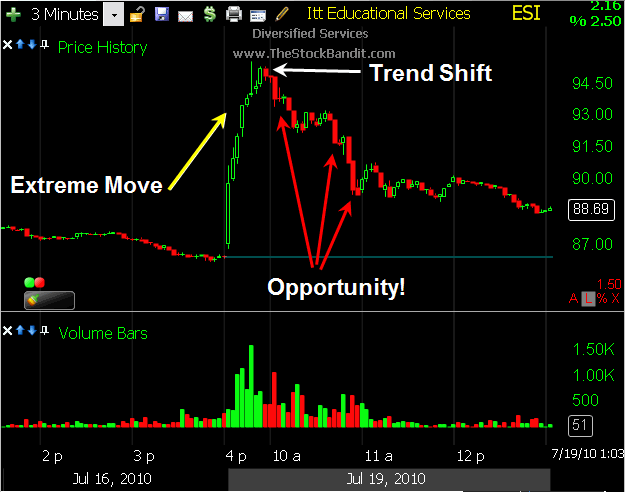
I outline my entire method for trading these extreme reversals in my Advanced Trading Course, so the specific details are reserved for students, but I will give you a few general pointers here.
Profiting from extremes begins with a mindset shift. When you see a giant move, don’t kick yourself for missing it. Instead, start looking for a way to profit once it’s over. Be creative – the market requires it!
Take note of intraday extremes. Don’t chase them, just watch them. See if the pace of the move begins to slow down, and at the first sign of a turn, you’ll know you’re looking at an opportunity. They will not all pan out, but the risk/reward associated with them makes them well worth studying, and often times quite lucrative to trade.
Trade Like a Bandit!
Jeff White
Swing Trading & Day Trading Service
www.TheStockBandit.com
Are you following me on Twitter yet?
Several Solars Set to Shine
July 19, 2010 at 7:17 am
Last week I discussed timing themes and the benefit of seeing repetition in the markets, but that’s just one way the astute trader can locate profits. Another is to notice sectors and groups which are seeing rotation.
Currently, solar stocks are making quiet but steady headway, exhibiting some very nice relative strength. While the market is bouncing from its most recent correction low, several solars are already in uptrends, boasting higher lows and higher highs.
Even better, there are a few of them which are looking poised for higher prices, provided of course that the patterns they’ve built are indeed confirmed.
I wanted to bring a few to you today and put them on your radar. Here’s a quick rundown of some setups I’m seeing…
SOL is pulling back in a shallow fashion here after a nice run, creating a bull pennant pattern. An upside resolution to this pattern could send this stock heading toward the spring highs:
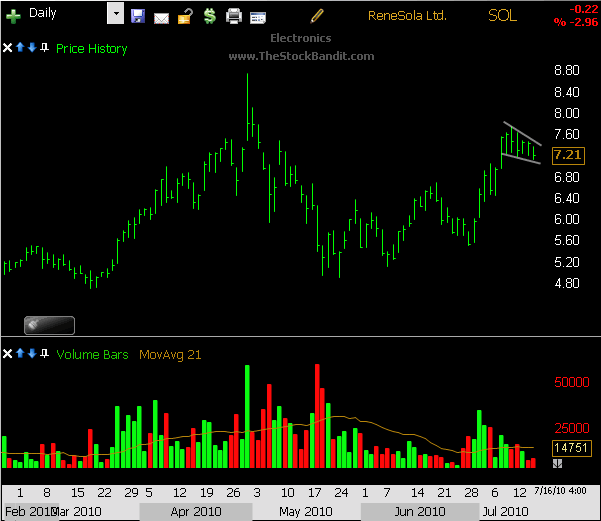
STP just confirmed a higher low with the creation of a higher high, and has been resting for a week. A return of strength would give this one plenty of room to run higher, but the consolidation area needs to be cleared first – until then, it’s simply resting:
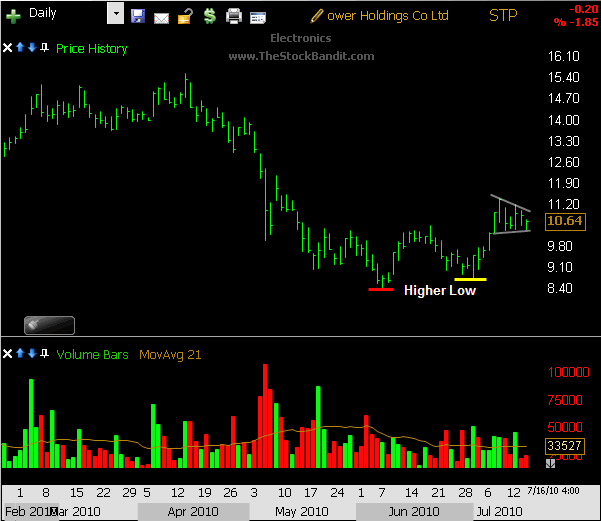
SOLF has been acting well, rising on strong volume in the past couple of weeks and basing here on quiet volume. An upside resolution to this bullish consolidation would technically be very positive:
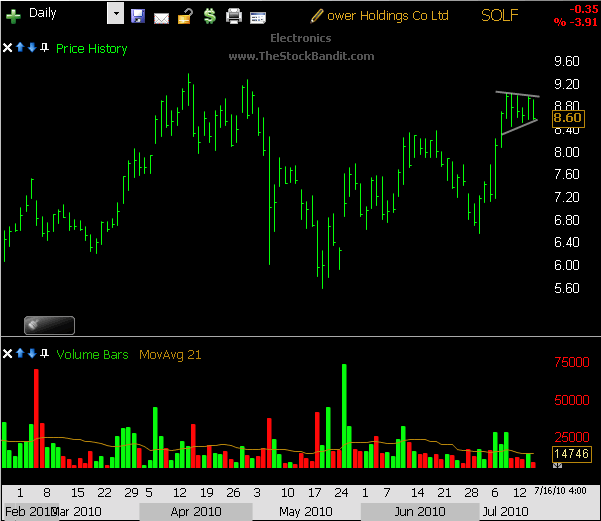
JASO jumped big from the July 1st low, confirming a short-term higher low and higher high. It’s been consolidating, and looks ready to challenge resistance:

TSL is already on the move out of its consolidation after creating a higher low in recent weeks, but still has room to run:
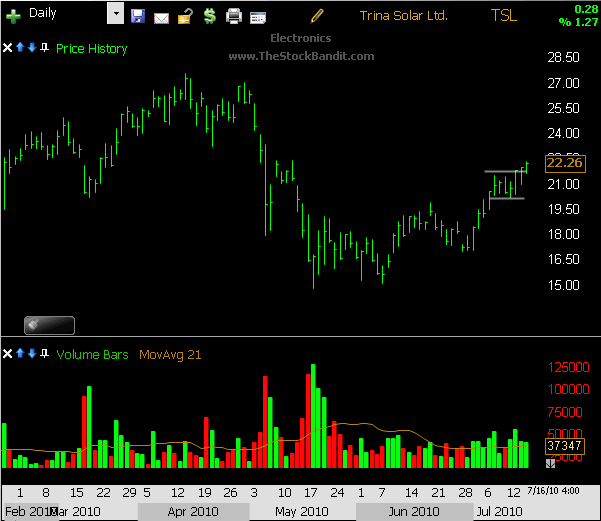
Even TAN, the solar ETF is looking good, so long as this bullish pattern gets confirmed with a move higher out of the consolidation. A higher low and a higher high have both been established:

Trade Like a Bandit!
Jeff White
Swing Trading & Day Trading Service
www.TheStockBandit.com
Are you following me on Twitter yet?
Three Pillars of Risk Management
July 14, 2010 at 6:41 am
As a Seinfeld fan, I really enjoyed The Fatigues episode where Jerry dates a woman with a mentor. George needs to give a report on Risk Management, and passes off the task to Jerry’s girlfriend so she can read all about it and save George time.
But Costanza isn’t the only one who doesn’t fully understand Risk Management. In fact, far too many traders struggle with this very topic, and it keeps them from surviving and from succeeding.
So, let’s look at 3 pillars of risk management as a way to keep it simple. If you can nail these down, you should be alright.
Protect Capital
This is a biggie, no doubt about it. Simple on the surface, but not easy to put into practice.
As traders, our capital is what keeps us in business. Ignoring the consequences of mismanagement is a major mistake that’s not easily recovered from. Those who fail to understand the importance of first preserving what they have tend to place profits ahead of protection. That leads to the age-old error of eyeing new trades with only potential gains in mind, rather than placing equal importance on potential losses if the trade fails.
Capital comes in two forms…psychological capital and trading capital. Both must be protected with vigilance.
Psychological capital is the amount of inner strength, confidence, and willingness to take risks that a trader possesses. It can be eroded through many mistakes, and it’s not easy to replace. Protecting one’s confidence as a trader is paramount to staying in this game, because the trader who’s unwilling to pull the trigger when good opportunities come along won’t ever win.
Trading capital is what’s available in your account, and it’s of course the type of capital most are familiar with. Money can be more easier to replace than confidence, but it’s still critical to manage risk in such a way that your account stays intact. Traders who disregard the importance of keeping an adequate capital base find out quickly they’re unable to profit big enough to matter, even when they’re right. So, try to maintain account highs as often as possible, and you’ll find your account is growing on a regular basis.
Trade YOUR Proper Size
This one will vary for everyone, so the secret is to make sure you’re trading position sizes which allow you to be at your best. That means avoiding trades which mean too much, both psychologically and financially. Let’s look at those one at a time.
Psychologically, the ability to recover from a loss is something we all must ensure. Taking a big hit from a trade which didn’t work out leaves us vulnerable to anger or despair, and neither are beneficial to our trading. Anger promotes revenge trades, and that typically leads to digging a deeper hole than that which we may find ourselves in. Despair leaves us so focused on our emotions that we fail to recognize good opportunities when they come along.
Financially, we never want to be trading so large that we can’t recover from a loss. Taking a fairly large position when you’re confident is one thing, but dumping your entire account into a single idea is another. Consider the math behind poor trades, for example. A 20% loss in your account will require a 25% gain to get back to flat. And the deeper that loss gets, the more that’s required to make it up. Taking several smaller trades instead of one big one might require more management, but it can also greatly help to avoid one major disaster.
Exit When You Know You Should
This sounds really simple, and it is, but it’s the follow through which makes this one difficult for some. Making a trading plan is one thing, but sticking with it can be another issue entirely.
It’s all about discipline, and that isn’t going to change. You know at which point you’ve stayed too long in a position and the time has come to kick it to the curb. All of us know what it means to blow stops, and most likely, it doesn’t pay off when we do. That’s a self-inflicted mistake that can be avoided, provided some measures are taken to help automate the process.
Here’s the thing…defined risks are the best kind. Pick your exit at the same time you select your entry, and commit to it. If you struggle with that, set a stop order the moment you’re filled on your entry, and then you won’t have to make a decision under the gun. If you get stopped, you most likely just saved yourself some additional pain. But you’ll be managing your risk effectively and reinforcing discipline even when you’re wrong.
If you’ll protect your capital, trade your proper size, and get out when you know it’s time, you’ll be doing 3 of the things the most successful traders focus on. How can there be any downside to that?
Trade Like a Bandit!
Jeff White
Swing Trading & Day Trading Service
www.TheStockBandit.com
Are you following me on Twitter yet?





